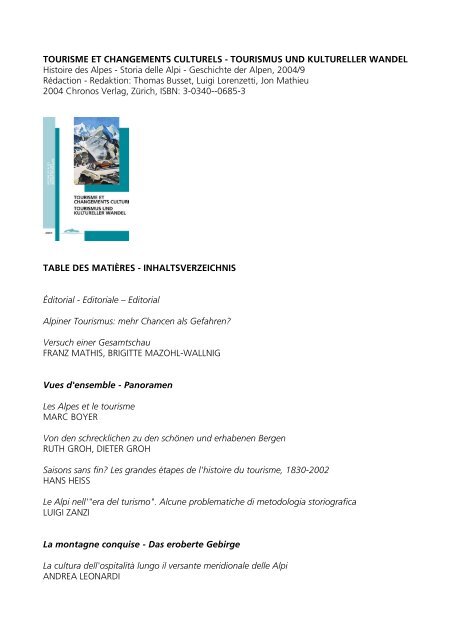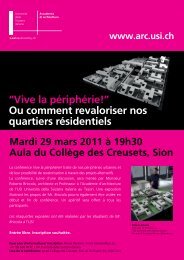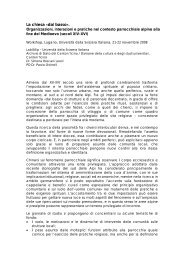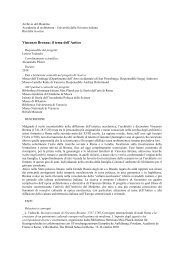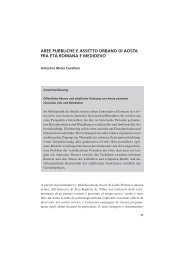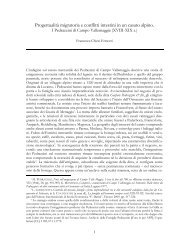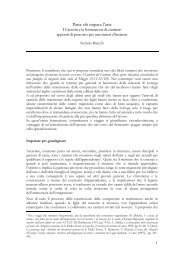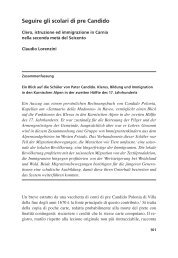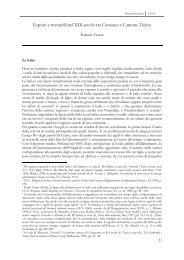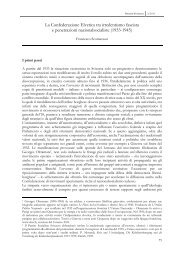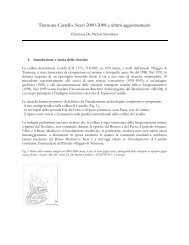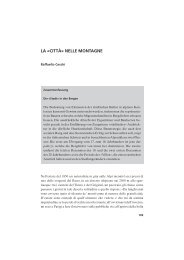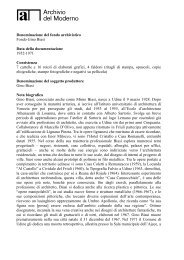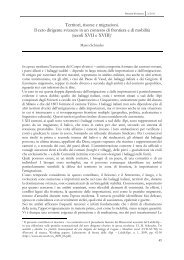TOURISME ET CHANGEMENTS CULTURELS - TOURISMUS UND ...
TOURISME ET CHANGEMENTS CULTURELS - TOURISMUS UND ...
TOURISME ET CHANGEMENTS CULTURELS - TOURISMUS UND ...
You also want an ePaper? Increase the reach of your titles
YUMPU automatically turns print PDFs into web optimized ePapers that Google loves.
<strong>TOURISME</strong> <strong>ET</strong> <strong>CHANGEMENTS</strong> <strong>CULTURELS</strong> - <strong>TOURISMUS</strong> <strong>UND</strong> KULTURELLER WANDEL<br />
Histoire des Alpes - Storia delle Alpi - Geschichte der Alpen, 2004/9<br />
Rédaction - Redaktion: Thomas Busset, Luigi Lorenzetti, Jon Mathieu<br />
2004 Chronos Verlag, Zürich, ISBN: 3-0340--0685-3<br />
TABLE DES MATIÈRES - INHALTSVERZEICHNIS<br />
Éditorial - Editoriale – Editorial<br />
Alpiner Tourismus: mehr Chancen als Gefahren?<br />
Versuch einer Gesamtschau<br />
FRANZ MATHIS, BRIGITTE MAZOHL-WALLNIG<br />
Vues d'ensemble - Panoramen<br />
Les Alpes et le tourisme<br />
MARC BOYER<br />
Von den schrecklichen zu den schönen und erhabenen Bergen<br />
RUTH GROH, DI<strong>ET</strong>ER GROH<br />
Saisons sans fin? Les grandes étapes de l'histoire du tourisme, 1830-2002<br />
HANS HEISS<br />
Le Alpi nell'"era del turismo". Alcune problematiche di metodologia storiografica<br />
LUIGI ZANZI<br />
La montagne conquise - Das eroberte Gebirge<br />
La cultura dell'ospitalità lungo il versante meridionale delle Alpi<br />
ANDREA LEONARDI
Parcours alpins sur le chemin de l'Italie: les transformations de l'image de la montagne dans<br />
les guides et récits de voyage en langue française des dernières décennies du XVIIIe siècle et<br />
du début du XIXe siècle<br />
GILLES BERTRAND<br />
Der Tourismus in den slowenischen Alpen vom Ende des 18. Jahrhunderts bis zum Ersten<br />
Weltkrieg<br />
OLGA JANŠA-ZORN<br />
Tourisme thermal et catastrophes naturelles en milieu de montagne. Barèges (XVIIIe-XIXe<br />
siècles)<br />
RENÉ FAVIER<br />
Il turismo visto dall'interno: alcune riflessioni a partire dalle fonti autobiografiche "alpine" tra il<br />
XVIII secolo e l'Età contemporanea<br />
SIMONA BOSCANI LEONI<br />
Eine aussergewöhnliche Landschaft als Kapital. Destinationsmanagement im 19. Jahrhundert<br />
am Beispiel von Zermatt<br />
CHRISTOPH MARIA MERKI<br />
"Mental maps" historischer Reiseführer. Zur touristischen Verdichtung von Kulturräumen in<br />
den Alpen am Beispiel der Brennerroute<br />
G<strong>UND</strong>A BARTH-SCALMANI, KURT SCHARR<br />
La montagne apprivoisée - Das gebändigte Gebirge<br />
À travers les Alpes. Le Montreux-Oberland Bernois ou la construction d'un système<br />
touristique, 1900-1970<br />
LAURENT TISSOT<br />
Die Automobilisierung des Blicks auf die Berge. Die Grossglocknerstrasse in Bildwerbung und<br />
Urlaubsalben<br />
CORD PAGENSTECHER<br />
Tourismus als Modernisierungsagentur und Identitätsressource. Das Fallbeispiel des Skilaufs in<br />
den österreichischen Alpen<br />
BERNHARD TSCHOFEN<br />
Hüttenkulturen im Vergleich. Italien und Österreich - Bilder, Strukturen, Optionen<br />
NIKOLA LANGREITER, MARGAR<strong>ET</strong>H LANZINGER<br />
Pour une mise en valeur touristique et culturelle des patrimoines de l'espace alpin: le concept<br />
d’"histoire totale"<br />
JEAN-PIERRE PRALONG
English summaries<br />
FRANZ MATHIS, BRIGITTE MAZOHL-WALLNIG: ARE THERE MORE BENEFITS OR RISKS IN<br />
ALPINE TOURISM? AN OVERVIEW<br />
Tourism has always generated, and still does, both opportunities and risks for the alpine<br />
regions. Which? This is the question to which the author is seeking an answer from each<br />
contribution to the present volume. The generic concept of Erweiterung (broadening) allows<br />
us to encompass the opportunities of tourism. Whether material or immaterial, this<br />
"broadening" process affects both tourist and local population or local hosts (knowledge,<br />
experience, health, income, lifestyle, closeness to nature, etc.). On the other hand, nearly all<br />
of these changes have entailed risks, too, which may be seen as the other side of the coin.<br />
The degree of emphasis placed on opportunities or risks depends largely on the observer's<br />
scale of personal values and priorities. Only by agreeing on a list of priorities will we be able<br />
to give a satisfactory answer to the initial question.<br />
MARC BOYER: ALPS AND TOURISM<br />
The author presents a bird's eye view of alpine tourism and its history, of which he<br />
reconstructs the main stages. Side-by-side with the industrial, agricultural, demographic, and<br />
banking revolutions, the tourist revolution whets the appetite for ostentatious travel,<br />
unconcerned about profit. Originally the preserve of the British, the trend gave rise to a new<br />
way of looking at the Alps, which gradually turned into the "playground of Europe" (Leslie<br />
Stephen). Sliding sports, too, are a British invention. In the twentieth century, the image of<br />
winter-time mountains as the domain of winter sports was to supersede their summertime<br />
image. Wherever the altitude of the place warranted the organisation of commercial activities<br />
in both seasons, the demographic shift turned out to be quite impressive. The "middle<br />
mountain" is a source of concern: below a certain altitude sufficient snow cannot be<br />
guaranteed; hence its future prospects are quite gloomy.<br />
RUTH GROH, DI<strong>ET</strong>ER GROH: FROM AWESOME MOUNTAIN TO BEAUTIFUL AND SUBLIME<br />
MOUNTAIN<br />
The present contribution is an enquiry into a change in perspective that began in the 16th<br />
century: from nature perceived as wild, sterile, and inhospitable - such as the landscape that<br />
meets us high up in the mountains - to a sensual nature that enchants those who<br />
contemplate her. There is nothing new today in seeing the mountains as a beautiful thing, so<br />
much so that one can easily believe it to have been the case from time immemorial. Not so!<br />
Up until the modern age, man had to go hunting and foraging and to grow his means of<br />
subsistence by trespassing on inhospitable nature. Hence the attribute of beauty was reserved<br />
for a nature that had shed its wild character, namely nature at its useful, tamed and cultivated<br />
best. Several factors led to this reappraisal between the 16th and the 18th centuries. The<br />
present authors concentrate especially on ancient traditions and the Swiss and English<br />
debates.<br />
HANS HEISS: SEASONS EVERLASTING? THE GREAT STAGES IN THE HISTORY OF TOURISM,<br />
1830-2002<br />
To outline the history of tourism the author describes its significant successive stages. After<br />
the long incubation period of the great (leisure and educational /cultural) tours undertaken by<br />
young people of good breeding, the 1830s heralded the start of modern tourism. From the<br />
1860s onward, travel was made easier by the rapid expansion of the railway network in<br />
Europe: areas became more and more inter-connected. Tour operators helped the<br />
standardisation of travelling. The late 19th-century growing range of tourist opportunities,
prompted by an inflow of exogenous money, was only the precursor of an Inter-War<br />
phenomenon: mass tourism. Burgeoning from its earlier dynamics, mass tourism depends<br />
essentially on an evolution in demand generated by a wider and wider social base. In<br />
Germany, tourism was kick-started by the monetary reform of 1948. Finally, in the past 20<br />
years, air travel has enabled an increasing number of holiday-makers to choose destinations<br />
outside Europe, with detrimental results for several alpine resorts.<br />
LUIGI ZANZI: THE ALPS IN THE AGE OF TOURISM: SOME ISSUES OF HISTORIOGRAPHIC<br />
M<strong>ET</strong>HODOLOGY<br />
In a survey of the stages connecting elite tourism in the 18th-century with tourism for the<br />
masses in the 20th century, the author analyses the cultural sea change undergone by<br />
mountain populations as they were colonised by metropolitan society through a "tourist<br />
revolution" in progress during the past decades. The marketing demands typical of urban<br />
tourism have not simply subverted the image of the Alps, now seen as little more than<br />
"consuming places" characterised by a high concentration of investment capitals for space<br />
development; they have also distorted the very identity of mountain communities and the<br />
figure of the mountain dweller. Finally, retrieving some historical factors of development of<br />
the alpine tourist industry inspires the author to investigate new avenues leading him to build<br />
a picture of eco-historical and socio-cultural phenomena and dynamics of the age of tourism<br />
and of its impact on the alpine world.<br />
ANDREA LEONARDI: THE CULTURE OF HOSPITALITY IN THE SOUTHERN REGIONS OF THE<br />
ALPS<br />
Through a historical-economic perspective we show that the early success of alpine tourism<br />
was determined by a combination of factors. While these include the environment and<br />
communication networks, extra- and meta-economic factors are equally crucial in the building<br />
of infra-structure to welcome guests, hence in controlling major investment flows,<br />
instrumental for the success of some resorts. One such factor is the friendliness or diffidence<br />
with which potential guests are treated: these "qualities" have helped to strengthen (or<br />
weaken) the culture of hospitality. This sort of culture emerges well before the advent of mass<br />
culture; its significance is undeniable, as a form of competitive advantage triggering the takeoff<br />
of tourism. The essay points at some elements that allowed this culture to be promoted<br />
and consolidated in some regions of the Alps earlier than elsewhere. According to us,<br />
hospitality, too, contributed to merging endogenous initiatives with exogenous interests in<br />
such a way that the end product was attractive enough to stimulate tourist demand.<br />
GILLES BERTRAND: ALPINE ROUTES ON THE WAY TO ITALY: EVOLVING IMAGES OF THE<br />
MOUNTAINS IN GUIDEBOOKS AND TRAVEL NARRATIVES IN FRENCH IN THE LATE 18TH AND<br />
EARLY 19TH CENTURIES<br />
During the few decades striding the 18th and 19th centuries - sometimes dubbed the turning<br />
point of Enlightenment (1760-1820) - the mental picture created by guidebooks and narrative<br />
works published in French used by travellers touring Italy changed quite significantly.<br />
Originally, this picture is determined by a rejection of mountains, a pointless impediment<br />
softened only by historical references or by a religious presence, and which reflects an<br />
obsessive picture of danger or discomfort. At the same time, from the 1760s fascination sets<br />
in, for the contradictory and sublime vision evoked by chains of mountains. Guidebooks<br />
summon the traveller to admire the peaks or the vistas stretching out from high points, but<br />
also the praises sung to the waterfall or the tricks of light and shadow. Almost coining new<br />
stock phrases, the admiring gaze holds hands with scientific knowledge. However, having<br />
expanded for a time, this dimension fades in its turn in the early 19th century, gradually<br />
replaced by glorification of the tamed, landscaped mountain, in which the traveller moves
around feeling perfectly safe, even though he has not entirely vanquished his fears of steep<br />
paths and impervious spaces.<br />
OLGA JANSA-ZORN: TOURISM IN THE SLOVENIAN ALPS FROM THE END OF THE 18TH<br />
CENTURY TO THE FIRST WORLD WAR<br />
Leaving aside pilgrimages and other ancient forms of travel, the beginnings of tourism in the<br />
Slovenian Alps may be situated in the second half of the 18th century. There, tourism was<br />
reserved for an exclusive circle of travellers and mountaineers inspired by scientific interests.<br />
Yet, very soon health-spa tourism saw the light. In this respect, Bled played a pioneering role.<br />
There, a Swiss, Arnold Rikli, built in the second half of the 19th century a centre dedicated to<br />
natural therapies; this type of healthcare comprised air and sun therapy, baths and special<br />
dietary regimes. In that period, Kamnik specialised in therapies based on the Kneipp method.<br />
A cluster of spring baths resorts saw the light in the easternmost region of the Alps. At the<br />
end of the 19th century a number of holiday resorts took off, for example Jezersko, Kranjska<br />
Gora or Begunje. Many Verschönerungsvereine (embellishment societies) were set up. In<br />
1905, an association was founded for the promotion of tourism in Carniole. The age of<br />
winter tourism began in Upper Carniole even before World War I. The present contribution is<br />
an account of this expansion.<br />
RENÉ FAVIER: SPA RESORTS AND NATURAL CATASTROPHES AMIDST THE MOUNTAINS.<br />
BARÈGES (18TH-19TH CENTURIES)<br />
Hot spot of health tourism in the French Pyrenees, in the 18th century the resort of Barèges<br />
had to cope with many difficulties deriving from the fact that a great deal of people and<br />
equipment crowded into a hostile natural environment, especially in winter. From early on,<br />
security measures were put in place to safeguard the area from the threat of river floods and<br />
periodic avalanches. These provisions, however, are no guarantee against natural<br />
catastrophes on account of the resort's own dynamism and the clash between the<br />
imperatives of security and the material stakes. The example of Barèges shows that health spa<br />
tourism in the mountains may be seen as the matrix of regional planning policies<br />
implemented from the early 20th century to the benefit of winter sports.<br />
SIMONA BOSCANI LEONI: AN "INTIMATE" VIEW OF TOURISM: A FEW THOUGHTS CULLED<br />
FROM "ALPINE" AUTOBIOGRAPHIES B<strong>ET</strong>WEEN THE 18TH CENTURY AND TODAY<br />
The present paper suggests some thoughts on the issue of alpine tourism, in particular on<br />
how it has been seen and the impact it has exercised, judging from evidence gathered in<br />
autobiographical writings (Selbstzeugnisse) by local authors who lived between the end of the<br />
18th century and today. Comments and observations on tourism and tourists in these works<br />
vary a good deal, because the authors tend to concentrate on their family lives, on their own<br />
jobs and often they merely hint at themes related to this branch of the local economy. A<br />
closer look at a small group of texts has nonetheless borne out the usefulness of these<br />
sources for the study of tourism. Four aspects have been highlighted. To begin with, there are<br />
no (negative) description of the tourist; secondly, mass tourism became the object of criticism<br />
quite early on; thirdly, hot spring baths met with great success. Lastly, and interestingly, we<br />
find the local residents' reaction to the hotel-keepers' activity and to the innovations which<br />
tourism introduced into the life of the valley.<br />
CHRISTOPH MARIA MERKI: AN EXCEPTIONAL LANDSCAPE CAPITALISED. DESTINATIONS<br />
MANAGEMENT IN THE 19TH CENTURY: THE CASE OF ZERMATT<br />
Destinations management may be defined, on the one hand, as the gradual installation of an<br />
infrastructure whose development may be looked at from the viewpoint of economic history;<br />
this infrastructure facilitates access to resorts and makes a stay enjoyable. Destination
management on the other hand is a marketing process whereby landscapes are publicised to<br />
potential tourists. This advertising belongs to a tradition that has traditionally been studied by<br />
cultural historians. The tourist industry turns space into a commodity or product, investing it<br />
with meanings and symbols, awakening Wanderlust in the target public. If we want to<br />
understand why millions of people travel every year to a given place, we cannot help raising<br />
questions on both the incidental and the structural, on the theory as well as the physical and<br />
technical context. This is what the author of the present article does by looking at the case of<br />
Zermatt in the 19th century.<br />
G<strong>UND</strong>A BARTH-SCALMANI, KURT SCHARR: MENTAL MAPS OF TRAVEL GUIDES. TOURIST<br />
DENSIFICATION OF CULTURAL SPOTS IN THE ALPS, ON THE PATTERN<br />
OF THE BRENNER ROUTE<br />
An ever faster pace of life and production is a major feature of modernisation. In this paper,<br />
we study in what way this acceleration affects man's sense of nature and culture in the<br />
golden age of tourism. To this end, we turn to cognitive charts, or mental maps. This concept<br />
refers to the image individuals or groups have of their environment. Our documentary sources<br />
are the travel guides published before World War I; these publications stand out for their<br />
large print run. The examples of the Brenner road, linking Innsbruck to Brixen/Bressanone and<br />
of the Höhlenstein valley (also known as Valle di Landro) linking Toblach/Dobbiaco to Cortina<br />
d'Ampezzo testify to the fact that the expansion of tourism helped the "densification" not<br />
only of infrastructure but also of the information supply. This is what travellers' mental maps<br />
tell us.<br />
LAURENT TISSOT: ACROSS THE ALPS. THE MONTREUX-OBERLAND BERNOIS RAILWAY OR<br />
THE BUILDING OF A TOURIST SYSTEM, 1900-1970<br />
Using the example of the Montreux-Oberland Bernois Railway (MOB), a renowned Swiss tour<br />
operator whose original objective was to cross the Alps from north to south, the author<br />
analyses how a socio-technical network of alpine tourism came to be established. To build a<br />
railway, in fact, one needs to plug into quite substantial human, material, and financial<br />
resources, which as a result fuel a project that far outstrips its core function as a means of<br />
transport. MOB offers a tourist product that covers, in addition to transport, hotels,<br />
restaurants, and several attractions (cable trains, skiing slopes, etc.). In other words, it draws<br />
up a comprehensive strategy which combines all the necessary functions to create a tourist<br />
product.<br />
CORD PAGENSTECHER: WHEN THE MOUNTAINS ARE SEEN THROUGH THE EYES OF<br />
MOTORISTS. THE GROSSGLOCKNER ROUTE REPRESENTED IN PUBLICITY PHOTOGRAPHS AND<br />
HOLIDAY SNAPS<br />
The author looks at the way pictures taken by tourists crossing the Alps change from the<br />
1950s to the 1980s. On the basis of iconographic reproductions of the Grossglockner region,<br />
the author wonders about the effects of motoring on man's perception of the Alps: did<br />
motorists and coach travellers (who thanks to the German economic miracle poured onto the<br />
roads in droves) react in the same way to the romantic appeal of the majestic mountains?<br />
Basically, on the one hand case studies rely on the analysis of private and professional<br />
drawings and photographs published in tourist prospectuses and, on the other, on holiday<br />
photo albums put together by individuals. This visual history of post-war tourism highlights<br />
both continuity and change in the tourist's eye; it also shows the considerable impact of local<br />
propaganda on travellers hunting for beautiful views.<br />
BERNHARD TSCHOFEN: AUSTRIAN TOURISM SEEN AS A MODERNISING AND IDENTITY<br />
FACTOR. THE CASE OF SKIING IN THE AUSTRIAN ALPS
The boom of tourism and the attendant emphasis on alpine characteristics evolve differently<br />
in different countries. In Austria, undoubtedly more than anywhere else, tourist pictures have<br />
become the mainstay of identity construction. The present article looks at the way the<br />
expansion both of skiing and of the tourist industry helps us interpret modernity at the<br />
individual and the social levels. Besides focusing on the aftermath of World War I and on the<br />
aesthetics and ideology of the Austro-German youth - with its physical fitness ideals -, the<br />
author draws attention to values and forms of behaviour which winter tourism allows us to<br />
publicise and experience. The article is based on an analysis of representative images of winter<br />
tourism in Austria, in which the international grammar of sports and tourism is subservient to<br />
a patriotic syntax. In this context, skiing acquires a legitimate identity in the domain of nature<br />
as well as culture.<br />
NIKOLA LANGREITER, MARGAR<strong>ET</strong>H LANZINGER: A COMPARATIVE APPROACH TO ALPINE<br />
HOSTELS IN ITALY AND AUSTRIA - IMAGES, STRUCTURES, OPTIONS<br />
The object of this study is the different forms of alpine hostels located along the Carinthian<br />
ridgeway, on either side of the alpine watershed. That is in fact the meeting-point of two<br />
cultural models, the Austrian mountain shelter and the Italian mountain shelter. We are<br />
seeking to define to what extent the arrangement of hostels bears the marks of nationality<br />
and of the host's choices. How much, on the other hand, depends on structural limitations?<br />
To what extent do location, ease of access, means of transport and technical advance play a<br />
part? Whatever one does, concretely, in this mountain space is influenced by historical, sociocultural,<br />
political, and economic factors. If one wants to understand the differences, one<br />
cannot simply refer to structures alone, but one needs to pay attention to representations.<br />
That is why we look closely to myths, expectations, laws and values conveyed by the guards<br />
and the firms that run these "refuges".<br />
JEAN-PIERRE PRALONG: TOWARDS A B<strong>ET</strong>TER APPRECIATION OF THE TOURIST AND<br />
CULTURAL ASS<strong>ET</strong>S OF THE ALPINE REGIONS: THE CONCEPT OF "TOTAL HISTORY"<br />
In an attempt to make the most, culturally and touristically speaking, of alpine resorts and<br />
landscapes, this article aims to indicate an awareness-raising approach to people, in particular<br />
scientists and scientific facilitators, faced with a general public. Our aim is to help them call<br />
the public's attention to the fact that each place, each landscape is the outcome of a whole<br />
wealth of layered and interwoven traditions; this in turn enables them to gauge the historical<br />
depth - according to our definition of this term - of these territories. Concepts such as<br />
"heritage pyramid" and "total history" enable us to put forward a general teaching<br />
framework. The theoretical approach and the practical method outlined here are<br />
interdisciplinary (natural sciences / humanities) and attempt to redress the balance of scientific<br />
mediation between natural heritage (abiotic and biological) and human heritage, within an<br />
all-embracing definition of culture.
Adresses des auteurs - Anschriften der Autoren<br />
Gilles Bertrand, Centre de Recherche en Histoire et histoire de l'art sur l'Italie et les Pays<br />
Alpins, Université Pierre Mendès France, BP, 47, 1221 Avenue Centrale, F - 38040 Grenoble<br />
Cedex 9, gilles.bertrand@upmf-grenoble.fr<br />
Simona Boscani Leoni, Istituto di Storia delle Alpi, Università della Svizzera italiana, via<br />
Lambertenghi 10, CH - 6900 Lugano, simona.boscani@isalp.unisi.ch<br />
Marc Boyer, 9 rue des Remparts, F - 26260 Clerieux<br />
René Favier, Université Pierre Mendès France, Grenoble, Maison des Sciences de l'Homme -<br />
Alpes, BP 47, 1221 Avenue Centrale, F – 38040 Grenoble Cedex 9, rene.favier@upmfgrenoble.fr<br />
Dieter und Ruth Groh, Philosophische Fakultät, Fachgruppe Geschichte, Universität Konstanz,<br />
Postfach 5560, D 11, D - 78434 Konstanz<br />
Hans Heiss, Kalcherau 1, I - 39042 Brixen (BZ), H.Heiss@grueneverdi.bz.it<br />
Nikola Langreiter, Fakultät für Interdisziplinäre Forschung und Fortbildung, Schottenfeldgasse<br />
29/5, A - 1070 Wien, nikola.langreiter@univie.ac.at<br />
Margareth Lanzinger, Institut für Geschichte, Universität Wien, Dr. Karl Lueger-Ring 1, A -<br />
1010 Wien, margareth.lanzinger@univie.ac.at<br />
Andrea Leonardi, Dipartimento di Economia, Università degli Studi di Trento, Via Inama 5, I -<br />
38100 Trento, andrea.leonardi@economia.unitn.it<br />
Franz Mathis, Institut für Geschichte, Universität Innsbruck, Innrain 52, A - 6020 Innsbruck,<br />
franz.mathis@uibk.ac.at<br />
Brigitte Mazohl-Wallnig, Institut für Geschichte, Universität Innsbruck, Innrain 52, A - 6020<br />
Innsbruck, brigitte.mazohl-wallnig@uibk.ac.at<br />
Christoph Maria Merki, Liechtenstein-Institut Forschung und Lehre, Auf dem Kirchhügel, St.<br />
Luziweg 2, FL - 9487 Bendern, cm@liechtenstein-institut.li<br />
Cord Pagenstecher, c/o Berliner Geschichtswerkstatt, Goltzstr. 49, D - 10791 Berlin;<br />
pagenstecher@web.de<br />
Jean-Pierre Pralong, Institut de Géographie, Université de Lausanne, BFSH 2, CH - 1015<br />
Lausanne, Jean-Pierre.Pralong@igul.unil.ch<br />
Kurt Scharr, Institut für Geographie, Universität Innsbruck, Innrain 52, A - 6020 Innsbruck,<br />
Kurt.Scharr@uibk.ac.at<br />
Laurent Tissot, Institut d'histoire, Université de Neuchâtel, Espace Louis-Agassiz 1, CH - 2000<br />
Neuchâtel, laurent.tissot@unine.ch
Bernhard Tschofen, Institut für Europäische Ethnologie der Universität Wien, Hanuschgasse 3,<br />
A - 1010 Wien, ernhard.tschofen@univie.ac.at<br />
Luigi Zanzi, Dipartimento Storico Geografico, Università degli Studi di Pavia, Strada Nuova 65,<br />
I - 27100 Pavia, l.zanzi@tin.it<br />
Olga Jansa-Zorn, trestenjakova 1, SI - 1000 Ljubljana (Slowenien), matija.zorn@zrc-sazu.si


